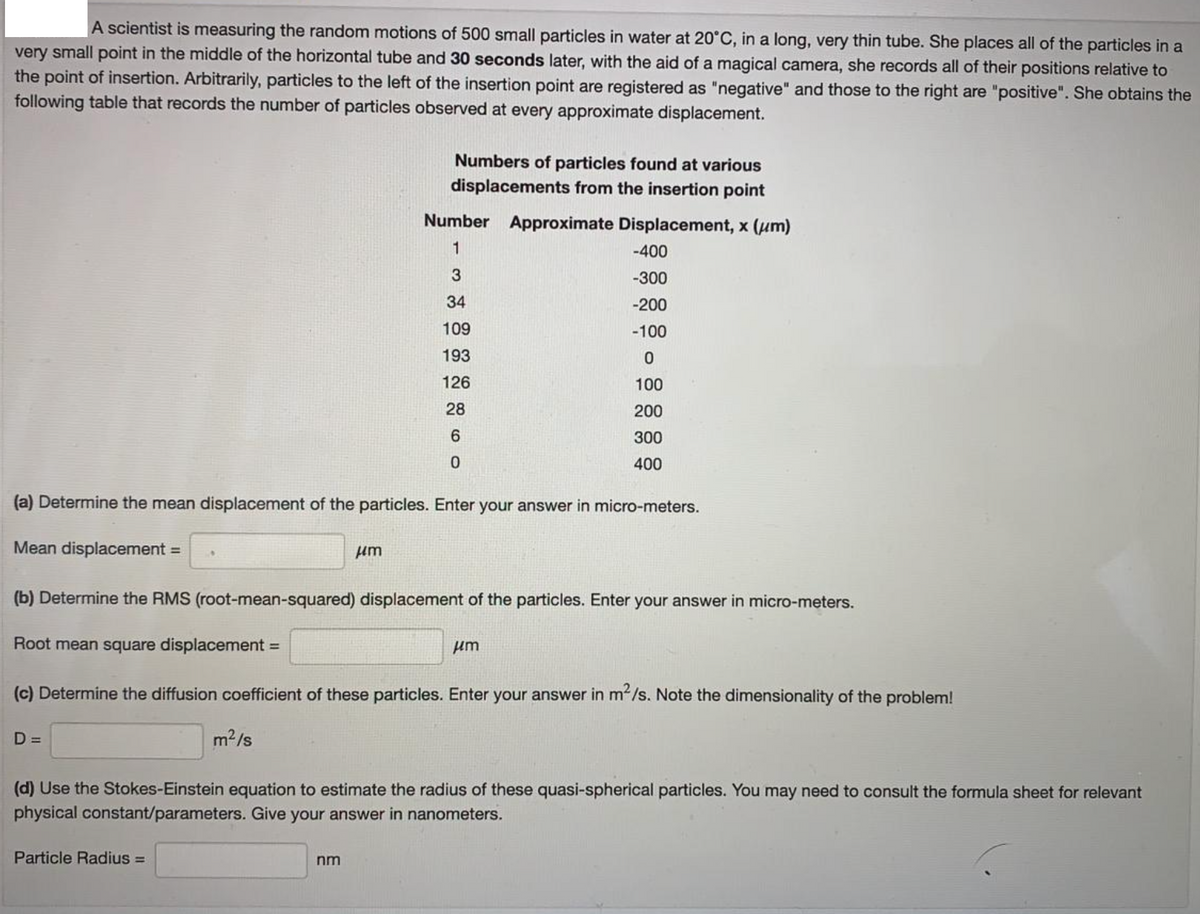A scientist is measuring the random motions of 500 small particles in water at 20°C, in a long, very thin tube. She places all of the particles in a very small point in the middle of the horizontal tube and 30 seconds later, with the aid of a magical camera, she records all of their positions relative to the point of insertion. Arbitrarily, particles to the left of the insertion point are registered as "negative" and those to the right are "positive". She obtains the following table that records the number of particles observed at every approximate displacement. Numbers of particles found at various displacements from the insertion point Number Approximate Displacement, x (um) 1 -400 3 -300 34 -200 109 -100 193 126 100 28 200 300 0. 400 (a) Determine the mean displacement of the particles. Enter your answer in micro-meters. Mean displacement = um (b) Determine the RMS (root-mean-squared) displacement of the particles. Enter your answer in micro-meters. Root mean square displacement = um (c) Determine the diffusion coefficient of these particles. Enter your answer in m/s. Note the dimensionality of the problem! D = m2/s (d) Use the Stokes-Einstein equation to estimate the radius of these quasi-spherical particles. You may need to consult the formula sheet for relevant physical constant/parameters. Give your answer in nanometers. Particle Radius = nm
A scientist is measuring the random motions of 500 small particles in water at 20°C, in a long, very thin tube. She places all of the particles in a very small point in the middle of the horizontal tube and 30 seconds later, with the aid of a magical camera, she records all of their positions relative to the point of insertion. Arbitrarily, particles to the left of the insertion point are registered as "negative" and those to the right are "positive". She obtains the following table that records the number of particles observed at every approximate displacement. Numbers of particles found at various displacements from the insertion point Number Approximate Displacement, x (um) 1 -400 3 -300 34 -200 109 -100 193 126 100 28 200 300 0. 400 (a) Determine the mean displacement of the particles. Enter your answer in micro-meters. Mean displacement = um (b) Determine the RMS (root-mean-squared) displacement of the particles. Enter your answer in micro-meters. Root mean square displacement = um (c) Determine the diffusion coefficient of these particles. Enter your answer in m/s. Note the dimensionality of the problem! D = m2/s (d) Use the Stokes-Einstein equation to estimate the radius of these quasi-spherical particles. You may need to consult the formula sheet for relevant physical constant/parameters. Give your answer in nanometers. Particle Radius = nm
Physics for Scientists and Engineers: Foundations and Connections
1st Edition
ISBN:9781133939146
Author:Katz, Debora M.
Publisher:Katz, Debora M.
Chapter20: Kinetic Theory Of Gases
Section: Chapter Questions
Problem 30PQ
Related questions
Question
Pls help on this question.

Transcribed Image Text:A scientist is measuring the random motions of 500 small particles in water at 20°C, in a long, very thin tube. She places all of the particles in a
very small point in the middle of the horizontal tube and 30 seconds later, with the aid of a magical camera, she records all of their positions relative to
the point of insertion. Arbitrarily, particles to the left of the insertion point are registered as "negative" and those to the right are "positive". She obtains the
following table that records the number of particles observed at every approximate displacement.
Numbers of particles found at various
displacements from the insertion point
Number Approximate Displacement, x (um)
1
-400
3
-300
34
-200
109
-100
193
126
100
28
200
300
0.
400
(a) Determine the mean displacement of the particles. Enter your answer in micro-meters.
Mean displacement =
um
(b) Determine the RMS (root-mean-squared) displacement of the particles. Enter your answer in micro-meters.
Root mean square displacement =
um
(c) Determine the diffusion coefficient of these particles. Enter your answer in m/s. Note the dimensionality of the problem!
D =
m2/s
(d) Use the Stokes-Einstein equation to estimate the radius of these quasi-spherical particles. You may need to consult the formula sheet for relevant
physical constant/parameters. Give your answer in nanometers.
Particle Radius =
nm
Expert Solution
This question has been solved!
Explore an expertly crafted, step-by-step solution for a thorough understanding of key concepts.
This is a popular solution!
Trending now
This is a popular solution!
Step by step
Solved in 2 steps with 1 images

Knowledge Booster
Learn more about
Need a deep-dive on the concept behind this application? Look no further. Learn more about this topic, physics and related others by exploring similar questions and additional content below.Recommended textbooks for you

Physics for Scientists and Engineers: Foundations…
Physics
ISBN:
9781133939146
Author:
Katz, Debora M.
Publisher:
Cengage Learning

Physics for Scientists and Engineers: Foundations…
Physics
ISBN:
9781133939146
Author:
Katz, Debora M.
Publisher:
Cengage Learning